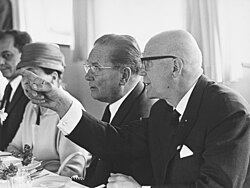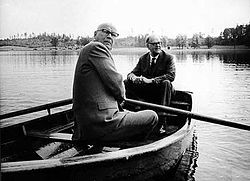Urho Kekkonen
Urho Kaleva Kekkonen (pronounced [ˈurho ˈkekːonen] (![]() listen); 3 September 1900 – 31 August 1986), often referred to by his initials UKK, was the President of Finland between 1956 and 1982. He was also the Prime Minister of Finland before that.
listen); 3 September 1900 – 31 August 1986), often referred to by his initials UKK, was the President of Finland between 1956 and 1982. He was also the Prime Minister of Finland before that.
Urho Kekkonen | |
|---|---|
 Urho Kekkonen in 1977 | |
| 8th President of Finland | |
| In office 1 March 1956 – 27 January 1982 | |
| Preceded by | Juho Kusti Paasikivi |
| Succeeded by | Mauno Koivisto |
| Prime Minister of Finland | |
| In office 20 October 1954 – 3 March 1956 | |
| President | Juho Kusti Paasikivi |
| Preceded by | Ralf Törngren |
| Succeeded by | Karl-August Fagerholm |
| In office 17 March 1950 – 17 November 1953 | |
| President | Juho Kusti Paasikivi |
| Preceded by | Karl-August Fagerholm |
| Succeeded by | Sakari Tuomioja |
| Personal details | |
| Born | 3 September 1900 Pielavesi, Finland, Russian Empire |
| Died | 31 August 1986 (aged 85) Helsinki, Finland |
| Nationality | Finnish |
| Political party | Agrarian League 1933–1965: Centre Party 1965–1982 |
| Height | 1.81 m (5 ft 11 in) |
| Spouse(s) | Sylvi Salome Uino |
| Children | Matti, Taneli |
| Residence | Tamminiemi |
| Alma mater | University of Helsinki |
| Profession | Lawyer, police officer, journalist |
| Signature | |
Kekkonen was born in Pielavesi. He took part of the Finnish Civil War. He was anti-Communist and later anti-Fascist.
Kekkonen became the Interior Minister in 1937, and he then attempted to ban the fascist party known as the Patriotic People's Movement (commonly abbreviated to IKL).
In the year 1950, after the Second World War, Kekkonen became the Prime Minister of Finland.
The "Passikivi-Kekkonen line" was a foreign policy doctrine established by, Kekkonen and Juho Kusti Paasikivi, aimed at Finland's survival as an independent sovereign, democratic, and capitalist country in the immediate proximity of the Soviet Union.[1]
Kekkonen was elected the President of Finland in 1956, after president Paasikivi. He attempted to keep Finland a neutral country, which means it was not affiliated with any military alliance such as NATO or the Warsaw Pact during the Cold War.
Urho Kekkonen led the underwriting of the Helsinki Accords of the Organization for Security and Co-operation in Europe between European countries, the United States and the Soviet Union in 1975.
Kekkonen became sick in 1981 and resigned from presidency.
He died in 1986, three days before his 86th birthday.
Urho Kekkonen Media
Young lawyer Kekkonen walking near Ateneum, Helsinki, in the early 1930s
Urho Kekkonen (left), Sylvi Kekkonen (second right), John F. Kennedy, and Jacqueline Kennedy in 1961 in Washington Dulles International Airport
Kekkonen's visit to the United States in 1961 and first time in the White House. Left: Urho Kekkonen, Sylvi Kekkonen, Jacqueline Kennedy, and John F. Kennedy.
Soviet leader Nikita Khrushchev attended Kekkonen's 60th birthday party in Presidential Palace, Helsinki. The party continued until 5 a.m. at the Tamminiemi residence.
President Kekkonen and his wife Sylvi in Mälkiä, Lappeenranta, in 1961
Kekkonen hunting with a rifle in Zavidovo, Soviet Union, in 1965
Kekkonen with the Prime Minister of Sweden Tage Erlander in a rowing boat in Harpsund, Sweden, in 1967
References
- ↑ Kekkonen diaries reveal how Paasikivi-Kekkonen line was born Archived 2015-01-09 at the Wayback Machine hs.fi









